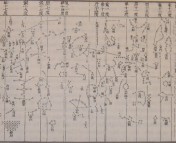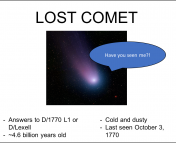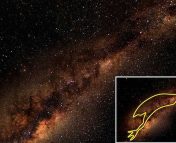One of the most common phrases used by academic papers in Astronomy and Astrophysics is “we need more data and will know more with better equipment in the future”. Undoubtedly, more advanced telescopes and deeper detections will help uncover a more complete perspective of the universe. While we are grateful for the technology we have today and look forward to more technological development in the future, we should also appreciate and feel amazed by the astounding contributions our ancestors made to science thousands of years ago without any “better equipment”. More importantly, these ancient records and findings still have a deep impact on modern science.
Although the system of modern astronomy is believed to be built on Greek findings in the western world, the earliest recorded discoveries of astronomical objects originated in the eastern world of Ancient China. In fact, the exploration of astronomy has been deeply embedded in Chinese culture and history. The word for “universe” in Chinese is comprised with two characters – “宇宙”, one meaning space and one meaning time. The theoretical support of this definition first appeared in 1907 when Albert Einstein developed the concept of general relativity. However, the Chinese word itself was invented before 200 B.C., and ever since has continued to demonstrate that the story of the universe has no boundaries in time or space.
Of all the astronomical objects traveling through time and space, comets are among the most popular documented by sky observers, including ancient Chinese.
As early as 168 B.C., Chinese ancestors constructed a complex set of illustrations of comet observations. Out of many scrolls discovered in 1973 from the Mawangdui Silk Texts, one specifically describes astronomical and meteorological phenomena, including 29 drawings of comets with different morphologies (Figure 1). Scientists estimate that, in order to produce such a figure, the observers might have kept a full record of ~100 comets. If our ancestors observed comets as frequently as we do nowadays, the observations may have taken ~1000 years and several generations of consistent documentation!
Although our ancestors didn’t understand the physical nature of astronomical objects as well as we do now, their astonishing records are still meaningful to modern astronomy.
Although many comets follow periodical trajectories, they lose a small part of their compositions each time they arrive close to the sun. Therefore, the dynamics and morphology of comets change over time. No. 29 in Figure 1 is a schematic illustration of an active comet. In this case, the rare active comet ejects so much gas and dust that it starts whirling on its axis. As many comets we know nowadays have lost their momentum (e.g., Encke’s Comet), we can take a glance at their previous active phases through these ancient documents. Moreover, in 648 A.D., at the beginning of the Tang dynasty in China (or Byzantine era in Rome), some observers had already studied the relation between the tail of the comet and its location in respect to the sun in the Book of Jin. After 900 years, the same relation was also discovered by European astronomers.
Up till now, historians have found evidence of amazing astronomical records in all ancient civilizations, including the visits of the well-known Halley’s comet. What makes ancient China stand out is not just the earliest records but also the scientific accuracy.
The New Book of Tang, a historical work covering the entire Tang dynasty, records activities of Halley’s comet from March 22 to April 28 in the year of 837 A.D.. During this period, the documents detail the observed time, location, length, shape and change of Halley’s comet every day until it disappeared. Although Halley’s comet was visible to the entire world at that time, historical records in other regions of the world show more poetic descriptions rather than Chinese observers’ scientific descriptions. In fact, the first “scientific documentation” in Europe as complete as the one in the New Book of Tang only occurred in 1456.
Furthermore, the timing of astronomical events recorded by ancient Chinese observers are very precise due to the usage of two calendars (lunisolar and sexagesimal) simultaneously. Moreover, historians can also use the evolution of Chinese characters and languages to further confirm the era of the discovered tablets, scrolls and papers. Therefore, it is surprisingly accurate to convert the dates of 29 observations on Halley’s comet over 2200 years from different Chinese dynasties to the modern calendar we use now.
Thanks to these detailed ancient records with precise dates, astronomers were able to revise the trajectory of Halley’s comet in 1982 after combining all previous observations dating back to 240 B.C.. They concluded that the period of Halley’s comet is not constant as 76 years but ranges from 76 to 79 years.
In addition to comets, ancient Chinese have made countless significant scientific contributions to modern astronomy:
- The earliest record of a supernova explosion in 185 A.D. (Han dynasty of China) supports the recent X-ray observational results on supernova remnant ‘RCW 86‘ in 2006.
- The thorough sky maps (Figure 2) made in 320 A.D. (Jin dynasty of China) led to an early estimate of axial precession as 1° change in 50 years without any modern equipment, while the accurate rate accepted today is 1° in 72 years.
- Among six different theories of the structure of the universe emerged in ancient China, “Xuan Ye Shuo”, proposed before 648 A.D., believes that the stars and the Milky Way are made of gas and float in the endless universe, which is surprisingly close to modern astronomy suggests!
Compared to the vastness of the universe, the life expectancy of humans can be ignored. However, looking back in history, it is clear that curiosity about the universe has remained constant across the boundaries of time and space. We, humans, look up into the same starry sky with wonder regardless of time, location, nationality, race, or any other difference. Meanwhile, every inch of the universe embraces us all equally.
Thanks to all the valuable ancient documents, we can now envision the sky our ancestors once looked up to. Those diligent and rigorous scientists in the early days of human civilization made unimaginable contributions to the history of astronomy. They began to compose human intelligence and devotion into a story of time and space, that we are continuing to write.
Reference: “4000 ans D’astronomi Chinoise” by Jean-Marc Bonnet-Bidaud
Edited by Gloria Fonseca Alvarez
Featured image credit: Pixabay




